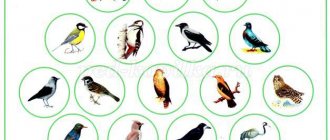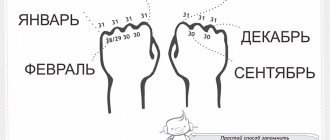MAGAZINE Preschooler.RF
Didactic game “Which tree is the leaf from?” (3-4 years)Goals of the game:
a) Didactic purpose:
- Expand children's understanding of trees
- Teach children to recognize by leaves and find different trees in the picture
- Clarify the names of trees and their parts
- Develop speech, attention, visual perception
- Enrich children's vocabulary with the names of trees and their fruits
- Develop fine motor skills of hands
b) Game goal:
- Play a didactic game
- Choose the right leaves for each tree
- Indicate the names of the trees to which the leaves are selected
Rules of the game:
— Number of players: from 1 to 7 people
— Game type: board
— The game continues until leaves for all the trees are found.
Attributes for the game:
— Cards with images of various trees: birch, chestnut, maple, etc.
— Chip cards with textile fasteners ( “Velcro” ) with images of leaves of different trees (correspond to tree cards)
Game actions and game content:
The game is played to consolidate knowledge of trees and their structure.
sticky chip cards , each of which corresponds to a specific tree.
There are two options for playing the game:
1) According to the lotto principle
The participants are given tree cards, and the presenter takes chips out of the box one after another, showing the leaves depicted on them. The player who discovers that the leaf fits his tree takes the chip and attaches it to his card. The first one to collect all the leaves and correctly name the tree wins. If there are more than two players, the game continues until there is only one loser left.
2) Independent game
Participants are dealt cards, and pre-mixed chips are laid out on the table. The players’ task is to independently find all the leaves for their tree and attach them to the card. The game is played “for a while” or for educational purposes - to consolidate the names of trees and their structure in memory, as well as learn to distinguish between different types of trees.
Game result:
— The teacher determines whether the child knows the names of trees, whether he can identify them from a picture, whether he names trees on cards and whether he knows what their leaves and fruits look like.
- It is indicated that the child played a didactic game, correctly/incorrectly matched the leaves to the tree, learned to identify trees from the image and name them.
| Next > |
Didactic game “Which tree is the leaf from”
Goal: to consolidate children’s knowledge about the nature of their native land, to consolidate the ability to form relative adjectives
(birch - birch, aspen - aspen, etc.)
Material: Pictures and illustrations of trees and shrubs and leaves
Progress of the game: The teacher shows pictures depicting a leaf, then a tree.
Didactic game "Nature and Man"
Goal: to consolidate children’s knowledge about what is created by man and what nature gives to man.
Develop skills of caring for nature
Material : pictures and illustrations on the topic.
Progress of the game: The teacher conducts a conversation and offers to tell what is made by man, and what by nature and how man
uses nature to make people's lives better.
Didactic game “What kind of berry is this”
Goal: to introduce children to types of berries and teach them to name them; teach to recognize berries that grow in Murmansk
regions; To develop children's attention, interest, and respect for plants.
Material: cards.
Progress of the game
Option 1:
The cards are on the children's table. The teacher names the berry, the children show the desired card.
Option 2:
From the total number of cards, children choose those berries that grow in the region.
Didactic game “Who is this?”
Goal: to consolidate children’s knowledge about the species of animals listed in the Red Book of the Kola Peninsula;
to educate children to understand the uniqueness of each animal species and the need to protect them.
Material: cut cards.
Progress of the game
Option 1:
From the proposed series of cards, children choose those animals that are listed in the Red Book.
Option 2:
The teacher shows a card with one or another animal listed in the Red Book of the Kola Peninsula, the children name it.
Option 3:
The teacher calls the name of the animal, the children choose the one they need from the proposed row of cards.
Game rule
:
The one who completes the task faster wins.
Didactic game “Who will I serve in the Army?”
Goal : To consolidate children's knowledge about military professions; develop imagination; instill pride in our Fatherland.
Material: pictures or photographs depicting weapons, equipment, objects and attributes used by the military. Progress of the game: Pictures or photographs depicting weapons, equipment, objects and attributes used by the military are placed in front of the children. Based on the choice the child made, the military profession should be determined. Name what troops the child wants to serve in when he grows up.
Didactic game “Which tree does the leaf go to”
Didactic toy
The meaning of educational toys :
— didactic toys are intended for the mental and sensory development and learning of children;
— designed taking into account a specific educational program, which is acquired by the child during the game;
— playing with educational toys , the child solves various problems. The conditions for such a task are contained in the design of the toy.
— the child not only improves the ability to act, but also masters sensory standards;
— the child’s actions become effective and purposeful;
the brightness, harmony of color and shape of toys evoke aesthetic experiences in the child.
We take 4 sheets of white paper and draw trees on them , only the leaves should be of different colors. For example: orange, red, yellow, green. After you have drawn the tree , take colored paper, the colors should match the trees and cut out leaves of different sizes . Our toy is ready.
The didactic game is a set of several trees of different colors and leaves of different colors and sizes. The course of the game is determined by the teacher, giving certain tasks to the children, or the children themselves come up with tasks for themselves during the game. This game can be used in groups of any age, as it helps solve problems. At a younger age, it can be used to determine the color and size of leaves , and at an older age, one of the tasks can be a quantitative ratio.
Solve problems, find the correct color and size of leaves , create quantitative relationships.
"Game of Moods" Didactic game for preschool children Title: “Mood Game” Age: children 4-7 years old Purpose: development of communication skills and the emotional-volitional sphere of children Age: children.
Summary of the didactic game “Run to the tree” Didactic task: To consolidate children’s knowledge about the trees that grow on the kindergarten site; learn to quickly navigate and find them.
Didactic game “Collect a piece of paper.” (oak, birch, maple). Dear colleagues, I present to your attention the didactic game “Collect a leaf” (oak, birch, maple). Goal: to reinforce in children. Photo essay “Wood carving in Rus'” For a long time, Russian people, having “fixed” the hut and finished field work, took up the art of carving on endless autumn and winter evenings. Photo report “Skilled wood artists” One day, you will come into contact with unusual beauty, and it will remain in your heart for a long time! Wood carving in Bali is a traditional art. Photo report “Wood carving workshop” Wood carving is a very delicate work, one wrong move and the work is ruined. Therefore, the master’s movements must be perfected. MK Didactic game “Which tree is the leaf from?” — senior preschool age Relevance The natural world is rich and diverse. But intensive human economic activity constantly makes changes and disrupts it. Photo report about participation in the “Give Life to a Tree” campaign Paper is the most familiar material to everyone from childhood and the most common material. How my children and I love to draw, make appliqués, and crafts from this. Introduction lesson “Pyrography-wood burning “Drawing with fire!” Introduction lesson: Pyrography – wood burning “We draw with fire!” Do you know what pyrography is? Translated from ancient Greek, it is beautiful.
Source
Didactic game “Which tree is the leaf from”
Natalya Averyanova
Didactic game “Which tree is the leaf from”
Didactic game “ Which tree is the leaf ”
.
Goal: to consolidate children’s knowledge of the names of trees , to attack the concepts of coniferous and deciduous , to promote the development of the ability to recognize plants by leaf .
Progress of the game: Show the children leaves from the trees and invite them to find out which tree they come from and find evidence (similarity)
with
leaves on a tree having a variety of shapes.
Equipment: subject pictures of leaves and trees .
Interactive game “Which tree is the leaf from”
Ekaterina Oleynik
Interactive game “Which tree is the leaf from”
Interactive game for preschool children “ Which tree is the leaf ”
Purpose of the game: to ensure the development of children’s ability to use ICT tools in gaming activities. Contribute to expanding knowledge about the trees of our strip . Ensure the development of children's ability to select leaves from trees .
Fix with children the names of trees , the appearance of leaves , fruits;
develop attention, observation, memory. Cultivate cognitive interest .
" Which tree is the leaf "
– educational
game for children from 4 years old . play it alone or in a small group. The game is very educational , it is good to use it for activities to familiarize yourself with the outside world in kindergarten or at home.
Progress of the game: Invite the child to name the tree , pick up a leaf for this tree and click the mouse . At the same time, explain to him that if the piece of paper is chosen incorrectly , it will remain in place and sway. If the leaf is chosen correctly , it will move towards this tree .
Attached files:
Presentation game “From which tree are the fruits” Objectives: clarifying children’s ideas about trees and their fruits; expansion and activation of the dictionary on the topic; formation of relative adjectives;
Didactic game “Which tree is the fruit from?” I bring to your attention a game for preschoolers. This game will help educators and parents consolidate children's knowledge about fruit trees and. Didactic manual doll Oktyabrina and the game “Guess the leaf” for senior preschool age Hello, dear colleagues! I would like to present to your attention an unusual doll “Oktyabrina”, which I made myself. In my opinion c.
Interactive Game Goal: to develop verbal and logical thinking, the ability to classify, compare, generalize, establish cause-and-effect, logical.
Interactive game “Where is the logic” A distinctive feature of our time is the rapid entry of information technology into all spheres of life. Modern children, k.
Interactive game on ecology Goal: expanding environmental horizons Objectives: • familiarization with the culture and nature of the native land, • development of cognitive interest.
Interactive game “Professions” The game consists of game tasks. Selecting the correct answers in each task is done by clicking on the pictures. Right and wrong.
Summary of an autumn walk “What tree is this leaf from?” Autumn walk “Which tree is the leaf from?” Author: teacher Lukinova S. Yu. Purpose: to continue acquaintance with maple, highlighting the characteristic ones. Master class on making a tree of happiness, a tree of wishes “Topiary” The last month of autumn has arrived, the rains have become more frequent, the temperature has dropped, people have warmed themselves. And how good it was in the summer - sun, sea, beauty.
Source
Outdoor game “Which tree is the leaf from”
The presenter displays 3 models of wood: maple, oak, birch. Each child has a piece of paper in their hands. To the music, children run in a circle after each other, then spin. When the music ends, the children run up to the corresponding tree and squat down. The presenter checks whether the task was completed correctly. Then the children can exchange leaves. Tree layouts can also be swapped. The game is repeated again.
Outdoor game “Let’s collect a bouquet of leaves of the same color”
Children run around the hall to cheerful music; when the music ends, they squat down. The presenter at this time raises a leaf, for example, yellow, to the top, and then the children who have yellow leaves in their hands run up to the leader and join their hands with the leaves into a bouquet. Then the music starts again and the children scatter around the hall.
The game is repeated as many times as there are leaf colors (you can use red, yellow, green and orange leaves). At the end of the game, the children give the leaves to the leader.
Outdoor game “Let's collect mushrooms”
Mushrooms are laid out in a circle on the floor (the number of mushrooms is less than the number of children). Children walk in a circle saying:
We're going, we're going, we're going,
We'll find mushrooms now
Under a leaf, under a blade of grass,
On a stump, under an aspen tree.
Here's a mushroom, don't yawn
And grab it quickly!
As soon as the last words are spoken, the children must quickly take any mushroom.
You can use music. To the music, children run merrily in a circle; when the music stops, each child must take a mushroom. Whoever doesn’t get a mushroom leaves the game and sits on a chair. The last child is the winner.
Outdoor game “Fruits for compote”
You will need 3 hoops of different sizes - these are jars. The presenter calls the children at will, puts headbands with images of fruits on their heads. Invites them to take a place in a large bank. To do this, first the leader places a large hoop on the floor. Fruits move around the hall to the music. When the music ends, the fruit takes up space in the jar. Whoever does not have enough space is eliminated from the game. The presenter praises the fruits that went into the first jar. The game is repeated again, the leader removes the large hoop and puts in a medium-sized hoop. You can invite others to play the game. The third time, the hoop is placed in a small size and the third jar is filled with fruit.
Outdoor game “The potatoes crumbled”
The driver is selected, he can sit on the bench. The participants of the game stand in a round dance. This is a potato (you can use headbands with a picture of a potato). Children walk in a circle and say the words:
Oh, you potato, you potato,
You feed honest people,
If there are potatoes in the house -
You'll be full all year round!
The presenter says:
And if the potatoes crumble, what should you do?
After these words, the participants scatter, the potatoes seem to crumble. The driver catches up with the children. He takes those whom he has caught up to his bench, as if collecting potatoes. The game repeats itself again. You can choose another child to play the role of driver.
Outdoor game “One-two-three! Collect the leaves!
Leaves are scattered on the floor. Children go for a walk to the music. When the music stops, the presenter gives the command to collect the leaves. For example: “One-two-three! Collect maple leaves!” or “One-two-three! Collect yellow leaves!” Command options can be varied, focusing on size, color, and type of tree. Each time after checking the completion of the task, the children give the leaves to the presenter. He scatters them again. For the last time, the leaves are placed in a basket and removed.
Creative task
"Color the Leaves"
The presenter invites the children to paint the leaves with autumn colors using cotton swabs. To do this, you will need leaf templates that can be mounted on 3 easels. It is necessary to select patterns of maple, oak and birch leaves. You can ask the children which tree the leaves come from and what paints will be needed to paint them. It is recommended to use large templates so that each child has enough space for creativity. Children should be divided into 3 groups accordingly.
Logorhythmic exercises
Progress of the game
We saw him dressed in spring and summer, but in the fall all the shirts were ripped off the poor thing. ( Tree )
.
-Where do trees ? (In the forest, in the garden, in the park, along the roads, in the courtyards of houses, etc.)
Conversation about trees .
- What types of trees ? ( deciduous and coniferous )
.
Deciduous trees are those that have foliage ; all coniferous trees have needles called needles instead of leaves. In winter , deciduous trees fall off , while coniferous trees retain their needles.
- Name the deciduous trees .
— Name the coniferous trees .
(Magical, calm music sounds)
The breeze caught us
Moved to the autumn forest.
(children open their eyes, on the slide there is an autumn forest with birds singing, children with a teacher go to the palace)
- Guys! Let's imagine that we are in an autumn forest.
- How should you behave in the forest? (children's answers)
- Look, there are trees in front of you and leaves on them . And I also have leaves that have gotten lost and can’t find their tree .
- Would you like to help them?
- How can we do this? (children's answers)
-Well, then let's help the leaves . Choose any tree that you like and sit down near it. Now, guys, we need to choose a leader who will take the leaves out of the basket . (Using a counting rhyme, children choose a leader, who takes out one leaf at a time and asks : “ Which tree is the leaf ?”
.
The game continues until the leader runs out of all the leaves ).
"Game of Moods" Didactic game for preschool children Title: “Mood Game” Age: children 4-7 years old Purpose: development of communication skills and the emotional-volitional sphere of children Age: children. Conversation “Which tree is the leaf from?” Goal: Continue to introduce children to trees and teach them to distinguish trees by their leaves. Develop mindfulness. Marina (tutor,. Children's master class on painting with paints "Autumn leaf in a vase" - a print from a tree leaf. Master class "Autumn leaf in a vase" was carried out by children of the preparatory group for school in mixed media: appliqué and non-traditional. Didactic game "With what kind of tree is a leaf" with children of the preparatory group Goal: to form children's ideas about different types of trees, their characteristics, benefits for humans. To develop cognitive interest. Master class "Pentaminoshes - a logical game made of wood" Hello, dear colleagues! I want to share more with you one idea of making and using the puzzle game "Pentamino" This is for everyone. MK Didactic game "From which tree is the leaf?" - senior preschool age RelevanceThe natural world is rich and diverse. But intensive human economic activity constantly makes changes to it, disturbing it. Autumn walk " What tree is the leaf from? Observing the maple" Autumn walk "Which tree is the leaf from? Observing the maple" Goal: to continue getting to know the maple, highlighting its characteristic features.
Source








